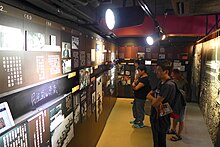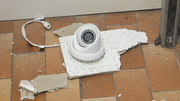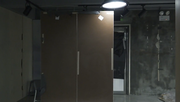June 4th Museum
Sáu bốn kỷ niệm quán | |
 Historical gallery. | |
| Established | 26 April 2014 |
|---|---|
| Location | No. 10, Ngai Wong Commercial Building, 11–13 Mong Kok Rd,Mong Kok,Kowloon,Hong Kong |
| Type | Private |
| Founder | Hong Kong Alliance in Support of Patriotic Democratic Movements of China |
| June 4th Museum | |||||||||||||
|---|---|---|---|---|---|---|---|---|---|---|---|---|---|
| Traditional Chinese | Sáu bốn kỷ niệm quán | ||||||||||||
| Simplified Chinese | Sáu bốn kỷ niệm quán | ||||||||||||
| |||||||||||||
TheJune 4th Museum,organised by theHong Kong Alliance in Support of Patriotic Democratic Movements in China,is a museum commemorating the1989 Tiananmen Square protests and massacrethat occurred in Beijing, China.
The museum was first located in a 1,375 sq ft. space inTsim Sha Tsui,Hong Kong. It opened on 26 April 2014, shortly before the 25th anniversary of the incident. However, the museum received many complaints from the building owners, with regards to breaches of the mutual covenant of the building. The museum closed on 11 July 2016.[1]
New premises were found to house the museum in a commercial premises inMong Kokand the museum reopened on 26 April 2019. The museum was once again closed on 2 June 2021 following a government probe into the museum's licensing status.[2]
Purpose
[edit]The purpose of the museum is to give Chinese people, in particular residents frommainland China,an opportunity to learn more about the Tiananmen Square protests of 1989, the history of which iscensored in China.Local residents can also explore the history of democracy and freedom in China.[3]
Museum
[edit]Temporary museums (2012–2013)
[edit]Before the permanent museum first opened in 2014, there were two temporary museums open for short periods—the first in 2012 and then in 2013. The temporary museums were named4 June Memorial Museum(Sáu bốn kỷ niệm quán), hosted by the Hong Kong Alliance in Support of Patriotic Democratic Movements in China. The first temporary museum was located at 269Yu Chau Street,Sham Shui Po,Hong Kong, and was open between 29 April and 10 June 2012. The second was located at I-Café in theCity University of Hong Kongfrom 12 April through 15 July 2013.[4]
Tsim Sha Tsui location (2014–2016)
[edit]The permanent site was on the fifth floor of the Foo Hoo Centre at 3 Austin Avenue inTsim Sha Tsuiin Hong Kong. The owner of the site is the non-government organization Hong Kong Alliance in Support of Patriotic Democratic Movements in China. Costing 9.76 million Hong Kong dollars, the museum was named the4 June Museumin English, the Chinese name (Chinese:Sáu bốn kỷ niệm quánbeing the same as that used for the temporary museums.[5][6]It opened to the public on 26 April 2014. The museum occupied 800 square feet, and its budget was approximatelyHK$800,000 per year.[7]
A complaint was filed against the museum shortly before it opened by the corporation that owns the building housing it, claiming that the museum violated the building covenants, as it was not using the space as an office and would bring in an excessive number of visitors.[8]A lawsuit over the matter was funded not by the owning corporation but "privately" by its chairman.[7]In June 2015, the building management began demanding personal information from museum visitors, who reportedly felt "harassed" by security guards.[9]Albert Ho,chairman of the Alliance, alleged that the fight against the museum was "politically motivated", and that the museum's detractors appeared to have "unlimited resources". In light of the above challenges, the museum closed on 11 July 2016.[9]
Temporary museum (2017)
[edit]While searching for a permanent location in which to re-establish the museum, a temporary museum was opened in theJockey Club Creative Arts CentreinShek Kip Mei,Kowloon on 30 April 2017. It hosted a series of related events surrounding 4 June 2017 and closed down on 15 June.[10][11]
In 2018, the Alliance undertook a search for permanent premises in hopes of re-opening the museum before 4 June 2019.[12]
Mong Kok location (2019–2021)
[edit]

The Alliance purchased premises in Mong Kok in December 2018. About HK$1 million was spent renovating the space to house the museum on a permanent basis. The museum was broken in to and vandalised prior to opening.[13]The Alliance subsequently increased security at the premises. The new museum location opened on 26 April 2019.[14]The museum closed from December 2020 until late February 2021 due to theCOVID-19 pandemic in Hong Kong.The curator of the museum said that the Hong Kong government andnational security departmenthad not interfered with the operation of the museum after the imposition of theHong Kong National Security Law,which had come into force on 30 June 2020.[15]
TheFood and Health Department(FEHD) on 1 June raided the museum and initiated proceedings alleging that the museum had violated the Places of Public Entertainment Ordinance by operating without a licence. The museum closed and sought legal advice.[16] [2]
-
Entrance damage after the police investigation
-
Entrance CCTV damage after the police investigation
-
Reception desk empty after the police investigation
-
Exhibition board removed by police
Exhibits
[edit]The museum collection consists of artifacts, photographs and information related to the incident. These include the casings of rounds fired by thePeople's Liberation ArmyinTiananmen Squareand a raincoat which was worn by a resident of Hong Kong who went to Beijing to support the Democracy Movement. The museum also contains T-shirts signed by the student leaders includingWang DanandChai Ling.The museum provided a multi-media area, heritage area, history area and a library.[3]AGoddess of Democracystatue, which at 6 feet 4 inches (1.93 m) in height symbolizes 4 June, was to have been displayed in the permanent museum.[17]
A bottle of home-made liquor billed as "Eight Liquor June Four" – the word "liquor" (Rượu) is a homonym of "nine" (Chín) and sold for 89.64 yuan – all symbolising for the crackdown date was produced in 2016 by four activists in Sichuan. The bottle's label depicted "Tank Man" image from 1989, and boasted of being aged 27 years (for the 27th anniversary in 2016) with 64 percent proof. Although the product was seized, one bottle that survived was smuggled out of the country made a symbolic trip around the world, to the Middle East, France, the US and eventually Hong Kong, where it was put on display in the museum.[18]On 4 April 2019, the fourth of four Sichuan men who were arrested in 2016 for producing the liquor was sentenced to jail for 31⁄2years; the three other men were also charged with "picking quarrels and provoking trouble", but were instead given suspended sentences.[18]
With the future the museum seen as uncertain by museum staff including managerLee Cheuk-yanafter the imposition of the Hong Kong National Security Law, a fundraiser was started to preserve the exhibits in digital format.[19]
See also
[edit]References
[edit]- ^Kam, Vivian (11 July 2016)."Hong Kong museum commemorating Tiananmen massacre to close".CNN.
- ^abWong, Violet (2 June 2021)."June 4 Museum closed amid licensing probe".RTHK.Archived fromthe originalon 4 June 2021.Retrieved6 June2021.
- ^ab"Niánzhōng huígù: Xiānggǎng liùsì jìniànguǎn lǐwàngyáng sǐwáng zhēnxiàng"Cuối năm nhìn lại: Hong Kong sáu bốn kỷ niệm quán Lý vượng dương tử vong chân tướng[Year-end review: Hong Kong June 4th Memorial Museum, the truth about Li Wangyang’s death].Voice of America(in Chinese). 11 December 2012.
- ^"Liùsì jìniànguǎn chéng dà chóng kāi"Sáu bốn kỷ niệm quán thành đại trọng khai[June 4th Memorial Hall reopens].Apple Daily(in Chinese). 12 April 2013. Archived fromthe originalon 15 April 2014.Retrieved14 April2014.
- ^"Zhī lián huì chì 976 wàn gòu liùsì jìniànguǎn yǒngjiǔ dìzhǐ"Chi liên sẽ mắng 976 vạn mua sáu bốn kỷ niệm quán vĩnh cửu địa chỉ[Stakeholders Association spent NT$9.76 million to purchase the permanent address of the June 4th Memorial Hall].The House News(in Chinese). 18 December 2013. Archived fromthe originalon 7 June 2014.
- ^"`Liùsì jìniànguǎn'yánzhì 4 yuè 26 rì kāimù"“Sáu bốn kỷ niệm quán” duyên đến 4 nguyệt 26 ngày khai mạc[ "June 4th Memorial Hall" postponed to April 26].Apple Daily(in Chinese). 15 April 2014. Archived fromthe originalon 15 April 2014.Retrieved14 April2014.
- ^abChong, Tanna (27 April 2014)."June 4 museum opens amid protests and threat of lawsuit".South China Morning Post.Retrieved4 June2014.
- ^Chan, Yanmic (11 April 2014)."June 4th Museum runs into Trouble".HK Magazine.Archived fromthe originalon 15 April 2014.Retrieved15 April2014– viaIssuu.
- ^abLin, Gene (12 July 2016)."Hong Kong's memorial museum for Tiananmen Square Massacre closes".Hong Kong Free Press.
- ^Tong, Elson (5 April 2017)."Tiananmen memorial museum to run at Shek Kip Mei arts centre from April to June".Hong Kong Free Press.
- ^Kawase, Kenji (30 April 2017)."Hong Kong's June Fourth museum makes temporary comeback amid political pressure".Nikkei Asian Review.
- ^Yu, Kam-yin (13 November 2018)."Democracy group steps up hunt for premises for June 4 museum".Hong Kong Economic Journal.Archived fromthe originalon 14 November 2018.
- ^Cheng, Kris (8 April 2019)."Hong Kong museum commemorating 1989 Tiananmen Massacre vandalised".Hong Kong Free Press.
- ^Creery, Jennifer (26 April 2019)."'No need to worry': Hong Kong museum commemorating 1989 Tiananmen Massacre opens amid protests ".Hong Kong Free Press.
- ^Lam, Nadia (1 March 2021)."Museum reopens amid concerns over national security law's new 'red lines' in Hong Kong".South China Morning Post.Retrieved24 April2021– viaPressReader.
- ^Cheng, Selina (2 June 2021)."In Pictures: Hong Kong's Tiananmen Massacre museum shuts down after gov't says it has no licence".Hong Kong Free Press.
- ^"Yìshù xì shēng zhì mínzhǔ nǚshén xiàng zhì jìniànguǎn"Nghệ thuật hệ sinh chế dân chủ nữ thần giống trí kỷ niệm quán[Memorial Hall of the Statue of the Goddess of Democracy in the Art Department] (in Chinese). now. 18 April 2013.Archivedfrom the original on 19 April 2014.
- ^abChan, Kelvin (2 June 2017)."Illegal Tiananmen Square liquor arrives in Hong Kong".AP News.Retrieved6 May2021.
- ^Chow, Yoyo (7 July 2020). Doyle, Gerry (ed.)."Hong Kong Tiananmen museum turns to digitalisation after new law".Reuters.Writing by Farah Master.Retrieved24 April2021.







